Bibimbap, is popular rice dish from Korea usually made with rice, vegetables, meat, spicy chilli sauce and fried egg. But you can easily make it vegetarian using this recipe. Learn how to make vegetarian bibimbap recipe or vegan bibimbap with stepwise pictures and video.
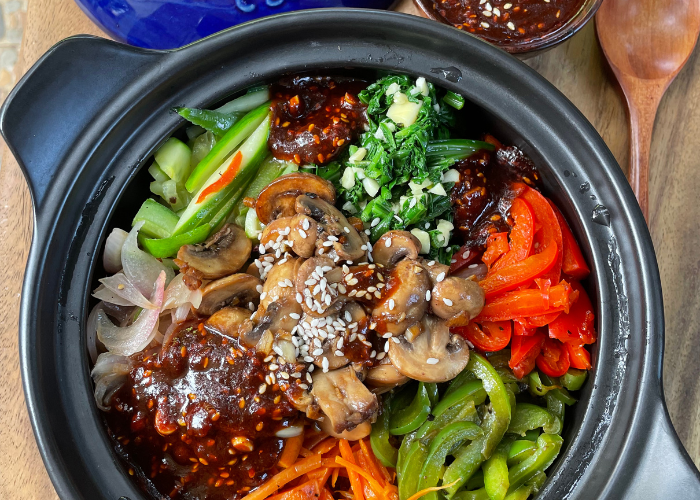
Bibimbap recipe
Vegetable Bibimbap is a korean popular dish and it taste so delicious. I have recently started loving korean foods. This one is on the top of my list. I have already shared a dolsot bibimbap recipe. This one is a vegetarian version.
Jump to:
About Vegetarian Bibimbap
Bibimbap is a Korean rice dish made with cooked rice, vegetables, fried egg and a spicy bibimbap sauce drizzled on top. Bibimbap is considered National dish of Korea. The word bibim means mixing and bap means rice.
Vegetables like spinach, zucchini, carrots, bell peppers and onions is cooked and seasoned with sesame oil and salt. Cooked vegetables is topped over cooked rice with a spicy gochujang, garlic sauce drizzled over. You heat the pot till the rice gets toasty. You mix everything really well before eating. Try my Jjangmyeon recipe.
Traditionally some kind of cooked seasoned meat and a fried egg is topped on the bibimbap. You can use mushrooms or tofu instead of meat. Multigrain rice, black rice or any rice is used in this dish.
Similar Recipes
Korean Vegetable Pancakes with Soy Dipping Sauce
Watch Vegetarian Bibimbap Video

My Love for Bibimbap
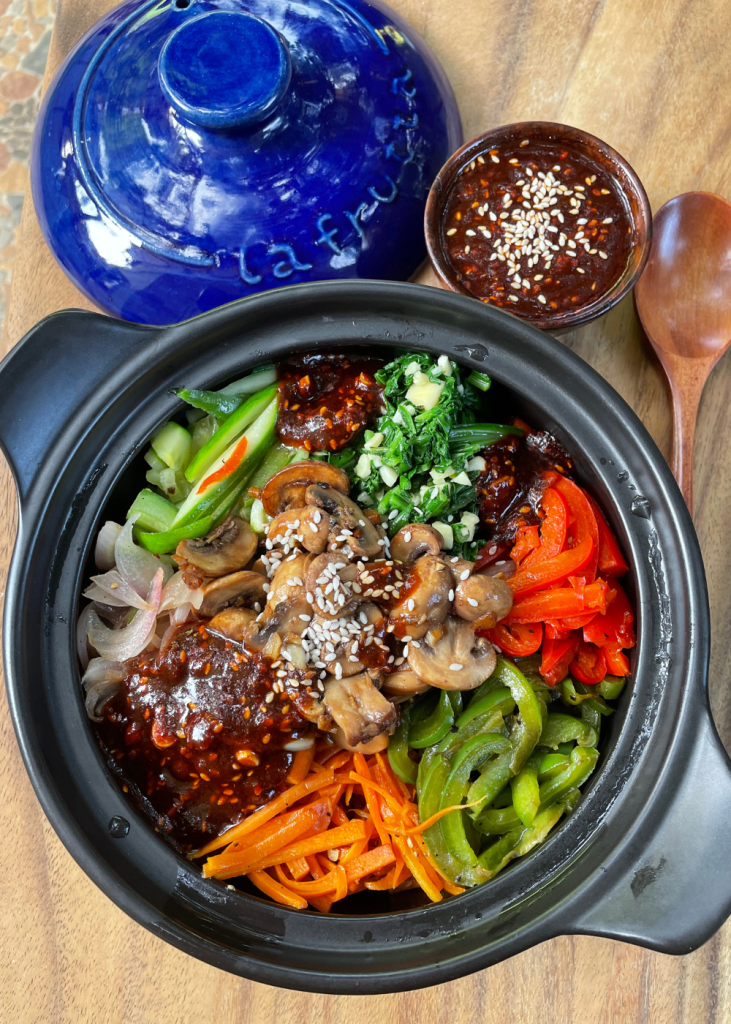
Bibimabap is considered super healthy and balanced meal because of the rice, vegetables, spinach and protein used. For vegetarian protein you can use tofu for added nutrients.
If you eat egg, make sure to top it with a fried egg for taste and added protein. Also for added protein you can use sauted bean sprouts.
Similar Korean recipes
Vegetarian Bibimbap Ingredients
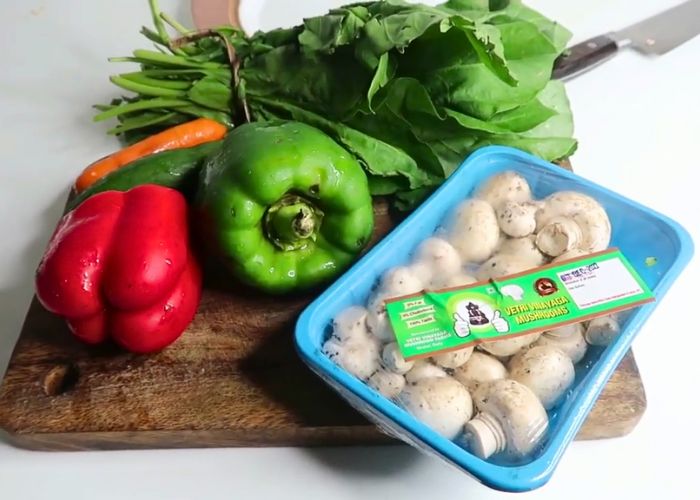
Rice - you can use short grain rice or jasmine rice in bibimbap. For more healthy alternative you can use multigrain rice, black rice or purple rice.
Vegetables - vegetables like carrots, bell peppers, cucumber, onions, zucchini, mushrooms is used in bibimbap. You cook the vegetables separately from the lighter colour vegetables to darker colour vegetables.
Garlic - finely chopped garlic is one of the main ingredient in flavouring bibimbap. Garlic is added with vegetables as well in the seasoning sauce.
Seasoning - The main flavour component in a bibimbap is the sauce which we make. But as far as seasoning the vegetables, we use garlic, soy sauce and toasted sesame oil.
Bibimbap Sauce
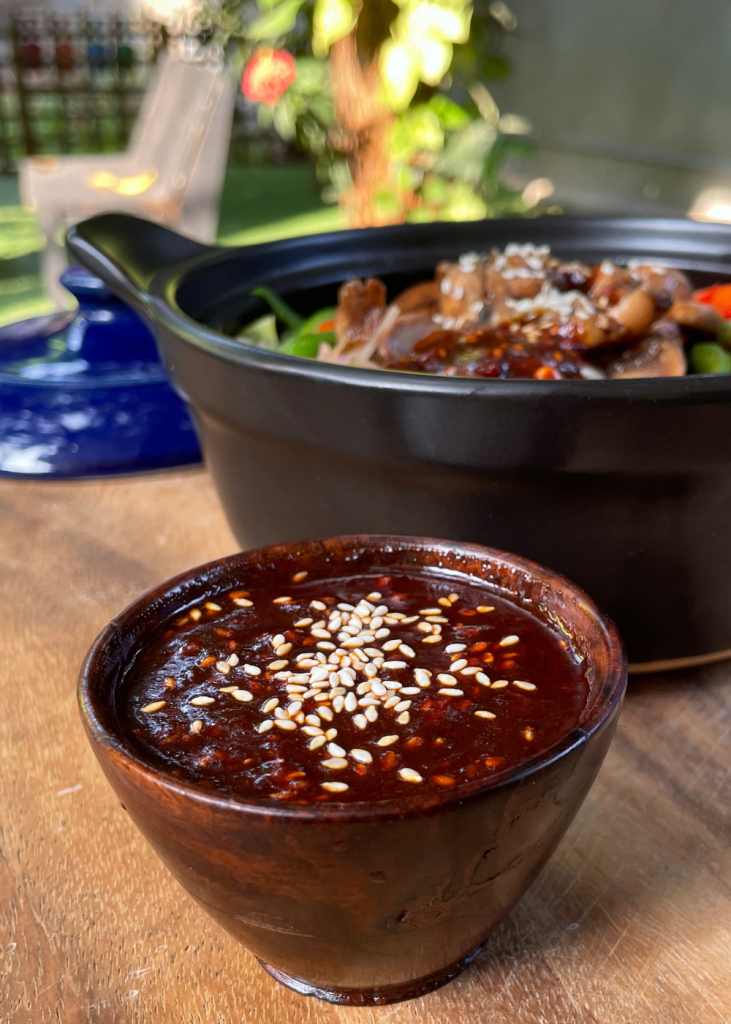
Bibimbap has a special chilli sauce that flavours the whole dish and brings all the ingredients and vegetables to life. The sauce can be tasted and customised to your preference. I love my bibimbap so flavour with the right balance of sauces. I create a balanced tasting sauce with chilli paste, vinegar, sugar, garlic, sesame seeds, toasted sesame oil and gochugaru which is Korean chilli powder.
Ingredients for bibimbap sauce
- 3 tbsp garlic chopped finely
- 3 tbsp Gochujang (Korean chilli paste)
- 1 tbsp Gochugaru (Korean chilli powder)
- 1 tbsp Rice Vinegar
- 2 tbsp Sugar or Brown Sugar
- 2 tbsp toasted sesame seeds
- 2 tbsp toasted sesame oil
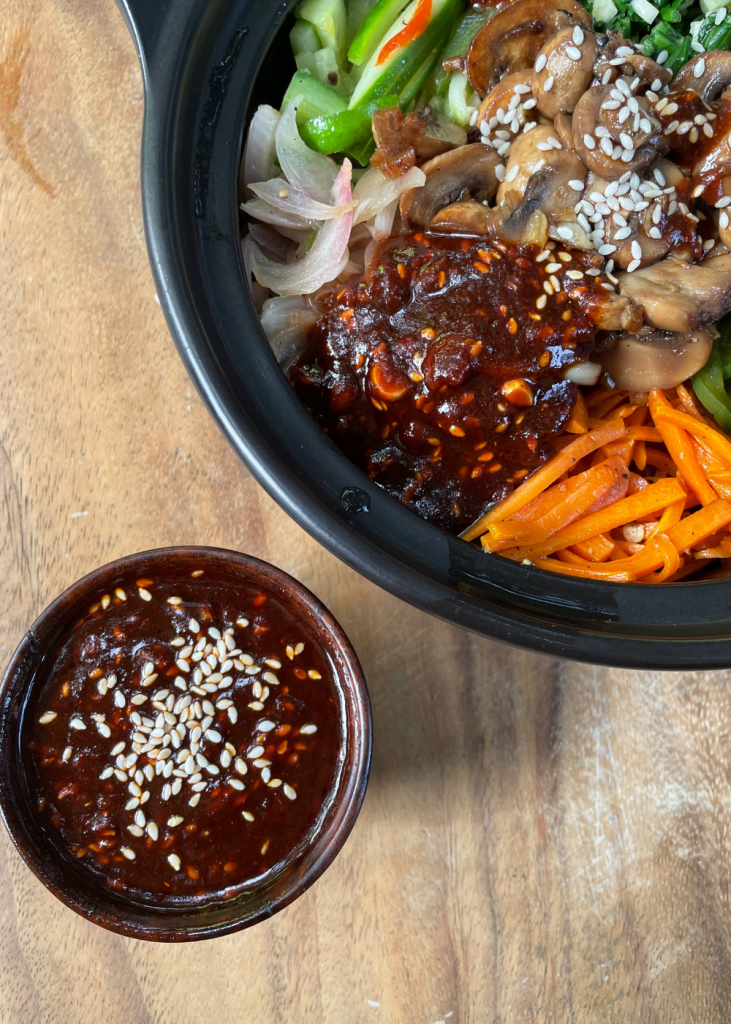
Variations
Bibimbap is made in different variations. Each region in Korea has their own version of making bibimbap.
Dolsot-bibimbap - Bibimbap is usually served in a heated stone pot which is known as dolsot.
Jeonju-bibimbap - Jeonju bibimbap is usually topped with soy bean sprouts, hwangpo-muk, gochujang, jeopjang, and seasoned raw beef.
Jinju-bibimbap - Jinju Bibimbap is made by cooking rice with beef broth, adding various vegetables, raw meat, hwangpomuk, stone seaweed.
Tongyeong-bibimbap - Tongyeong bibimbap is unique in that it uses seaweed such as hizikia fusiforme and raw sea mustard, and is served with soup boiled with clam and tofu. Tongyeong is a coastal area, so seaweed is included in bibimbap. Bean sprouts, spinach, leek, radish, zucchini, eggplant, and cucumber are also used.
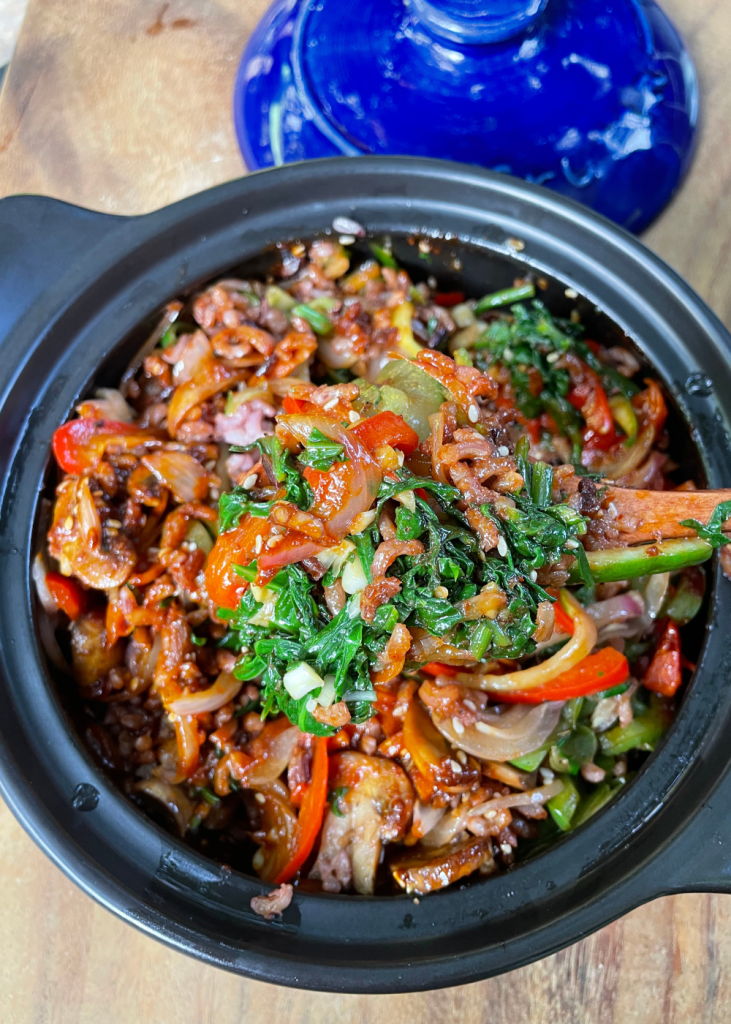
How to Make Vegetarian Bibimbap (Stepwise Pictures)
Cook Rice
1)I am using multi coloured rice which has a mix of black rice and brown rice. You can use any rice of choice.
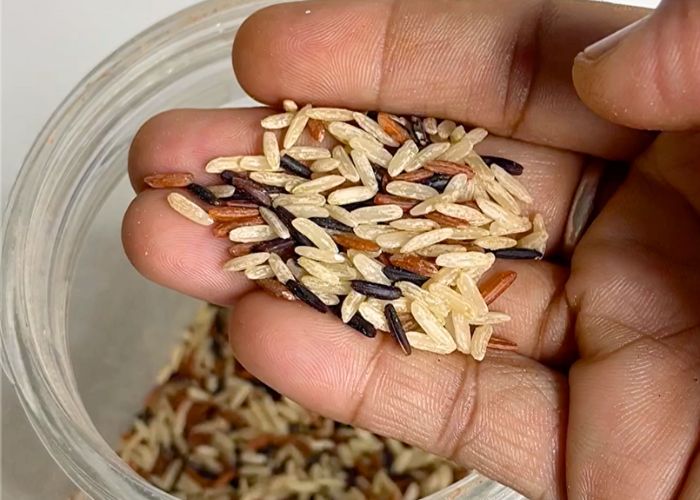
2)Now cook the rice. Wash the rice multiple times to remove the starch from it. You can soak the rice for 10 minutes if required. Now take the rice in a sauce pan, cover with water and cook on high until it comes to a full boil.
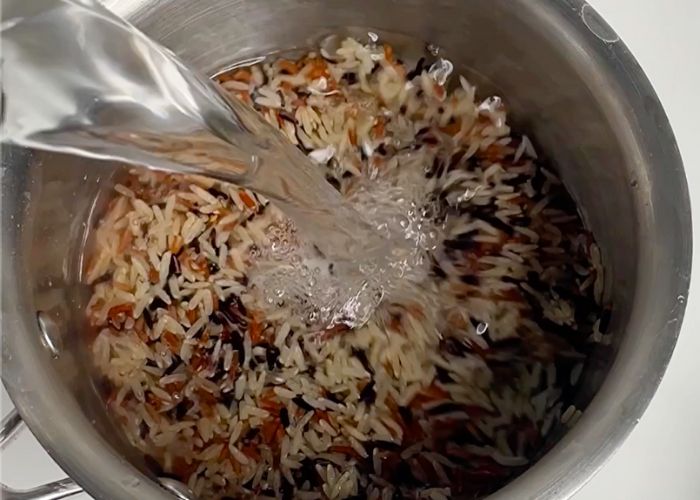
3)Now lower the heat and cook on low simmer covered for 10 minutes. Once the rice is cooked, open the lid and fluff up the rice. Set aside covered so it stays warm.
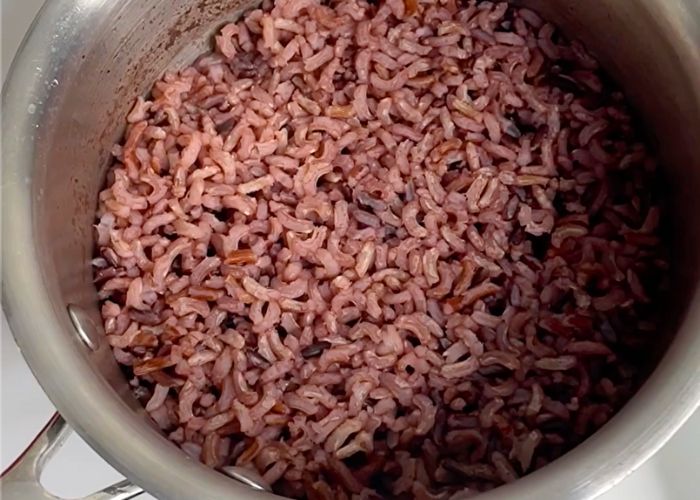
Bibimbap Sauce
4)Now lets mix the sauce. Take gochujang, garlic in a bowl.
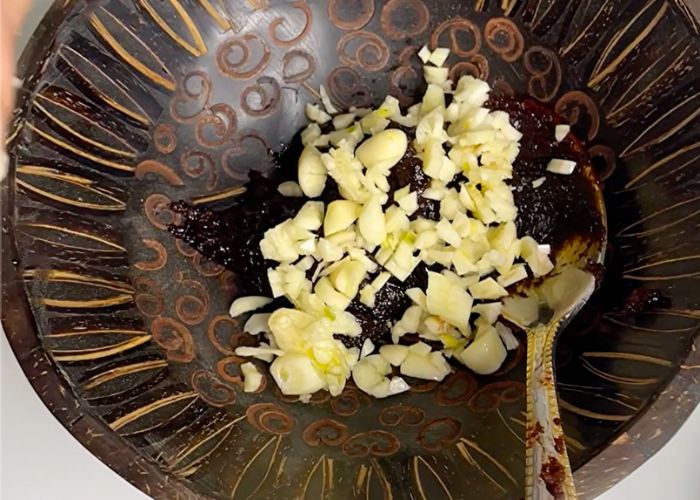
5)add in vinegar.
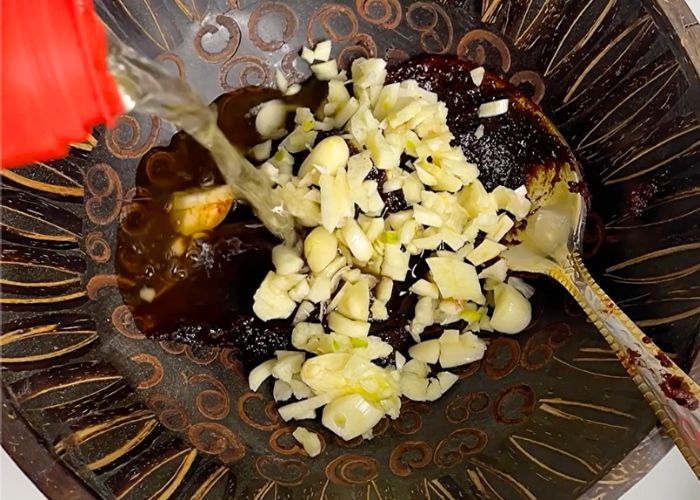
6)Add in sugar to taste. Instead of sugar, you can use honey or rice syrup.
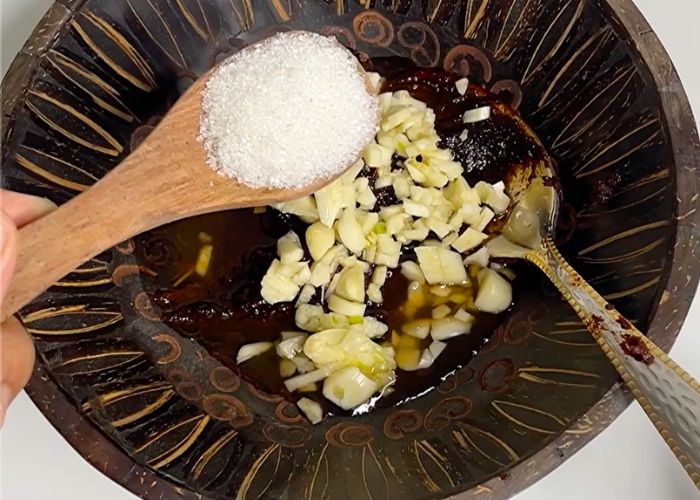
7)Add in toasted sesame oil.
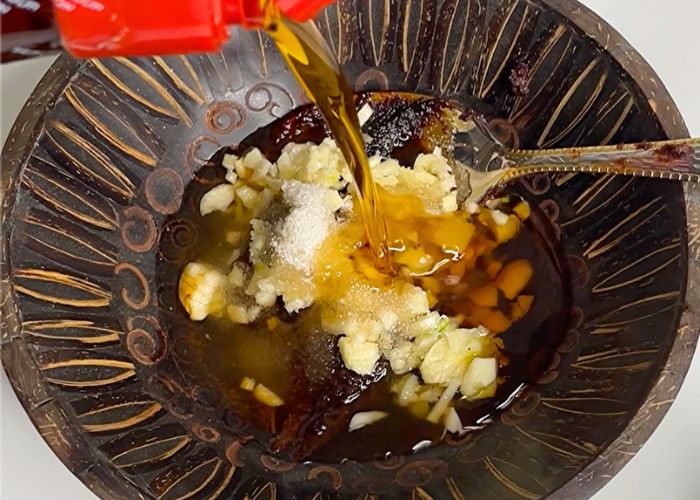
8)Add in korean chilli powder and toasted sesame seeds.
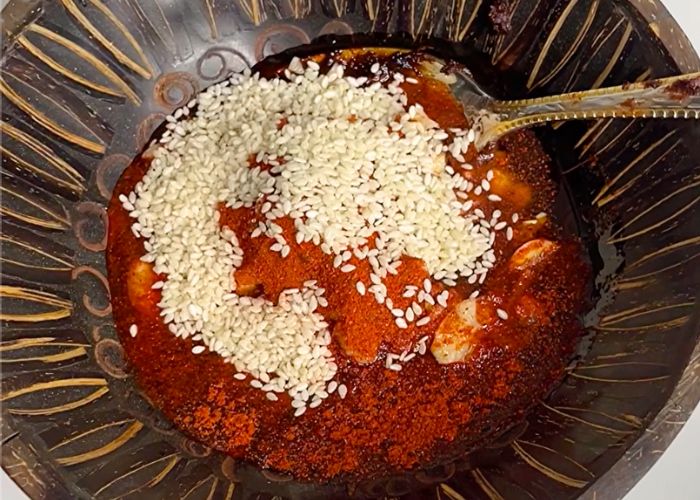
9)Mix this really well, your sauce is ready.
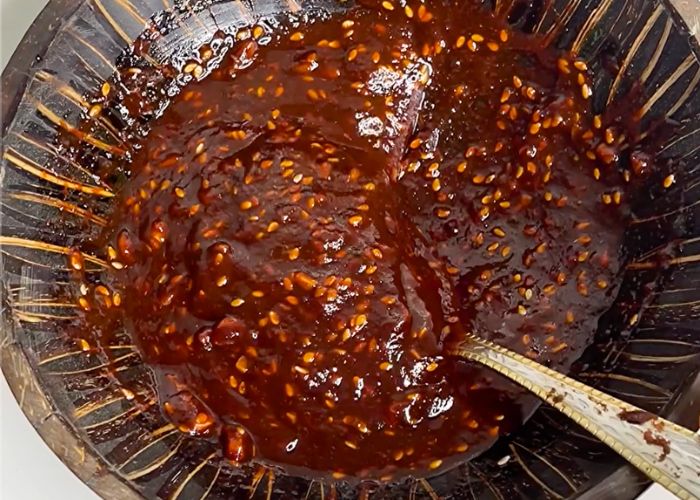
Cooking Spinach
10)Now lets cook the vegetables. First blanch spinach in boiling water for 1 minute. Now squeeze and extract as much water as possible. Chop the spinach into small pieces. Now take the spinach in a bowl. Add in toasted sesame oil, salt, pepper and garlic. Mix well. Set aside.
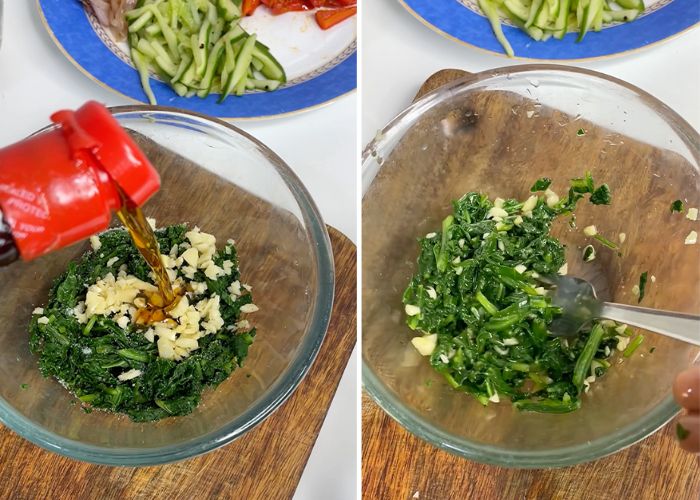
Cooking Vegetables
11)Now cook the vegetables one by one. Start with the lighter colour vegetables and then cook the darker colour veg. Heat oil in a pan, add in onions and season with salt and pepper. Saute on high for 2 minutes. Remove to a bowl.
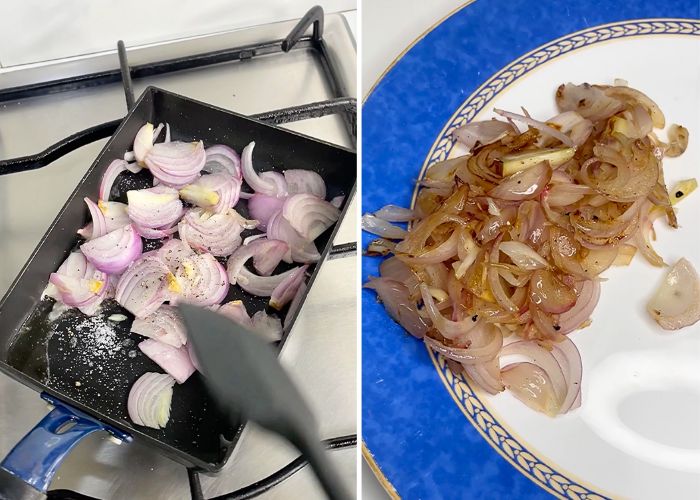
12)In the same pan, add 1 tsp oil and saute cucumber with salt and pepper for couple of minutes. Remove to a bowl. Same way cook bell peppers and carrots. Set aside once cooked.
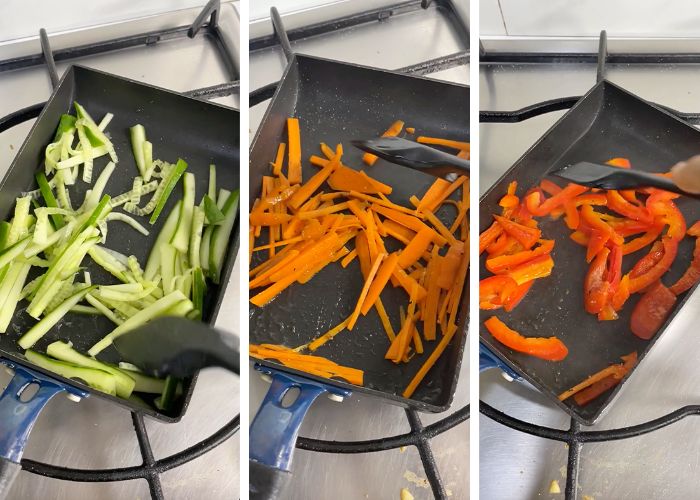
13)Now lets cook the mushrooms. Heat oil in a pan. Add in mushrooms and cook on high heat for 3 to 4 minutes. Add in salt, pepper and soy sauce. Toss on high heat for a minute. Now remove and set aside.
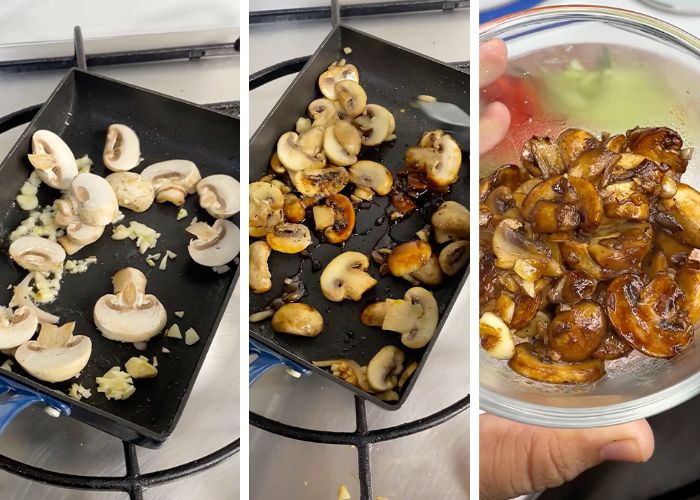
Assemble bibimbap
14)Heat a stoneware pot. Add a tsp of oil in the base.

15)Spoon the cooked rice in the base of the pot.
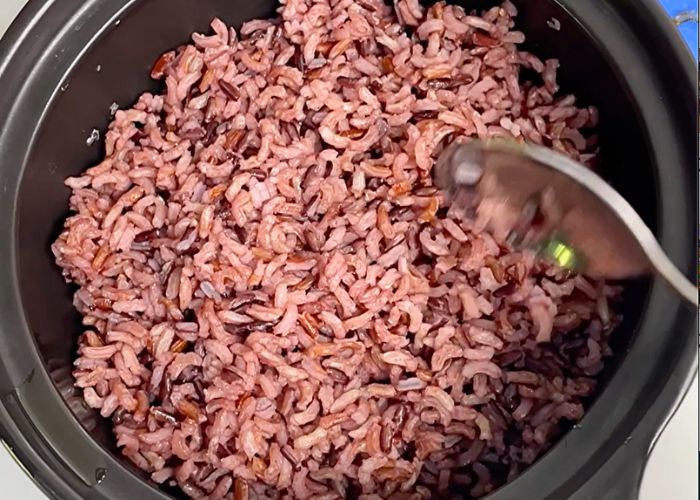
16)Top the rice with all the vegetables.
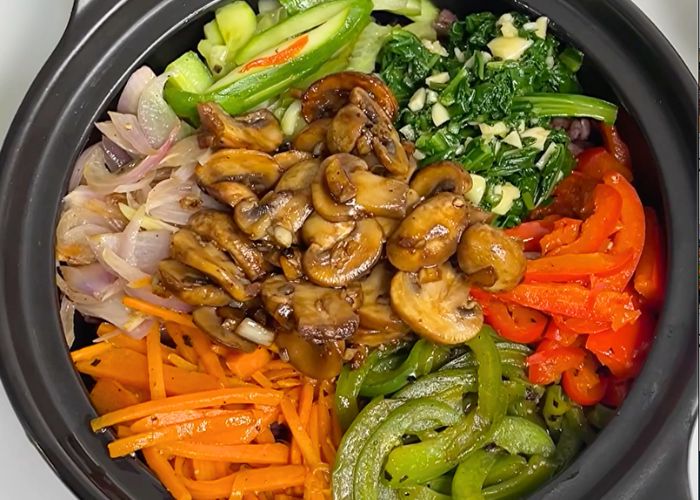
17)Spoon some of the sauce.
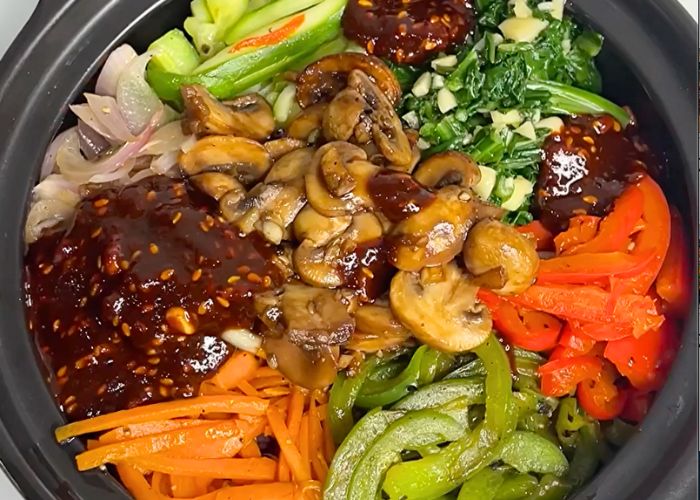
18)Place the pot on heat and cook on medium high for 5 minutes. Now mix well and enjoy.
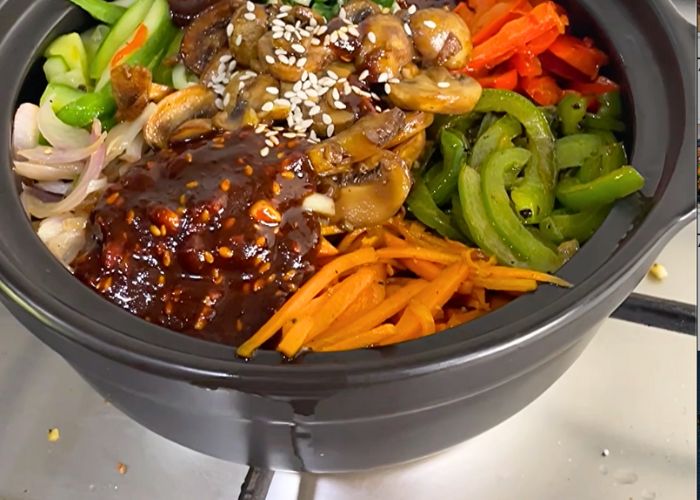
Expert Tips
- You can use any vegetables that you prefer. Zucchini, corn, bokchoy can be cooked and added in bibimbap.
- If you eat meat, you can add cooked meat of choice.
- Fried egg can be topped over bibimbap for more taste.
- Once assembled, heat the pot for few minutes until it is sizzling and serve hot.
- Bibimbap taste great when served with kimchi.
More Korean Inspired Recipes to Try
📖 Recipe Card
Vegetarian Bibimbap Recipe
Equipment
- Stone pot
- cooking pan
Ingredients
For Bibimbap sauce
- 3 tbsp Garlic peeled & chopped finely
- 3 tbsp Gochujang Korean chilli paste
- 1 tbsp Gochugaru Korean chilli powder
- 1 tbsp Rice Vinegar
- 2 tbsp Sugar or Brown Sugar
- 2 tbsp Toasted sesame seeds
- 2 tbsp Toasted sesame oil
For Rice
- 1 cup Rice
- 2 cups Water
For Spinach
- 4 cups Spinach Palak
- 2 Cloves Garlic peeled & chopped finely
- ¼ tsp Salt
- ¼ tsp Black Pepper powder
- 1 tbsp Toasted Sesame Oil
For Sauteing Onions
- 1 tsp Oil
- 1 large Onion peeled & sliced thinly
- ⅛ tsp Salt
- ¼ tsp Black Pepper powder
For Sauteing Mushrooms
- 1 tsp Oil
- 2 cloves Garlic chopped finely
- 20 no Mushrooms sliced thinly
- 1 tsp Soy sauce
- ¼ tsp Salt to taste
- ¼ tsp Black Pepper powder
For Cucumber
- 1 tsp Oil
- 1 no Cucumber Juliened
- ¼ tsp Salt
- ¼ tsp Black Pepper powder
For Carrots
- 1 tsp Oil
- 1 no Carrot Juliened
- ⅛ tsp Salt or to taste
- ⅛ tsp Black Pepper powder or to taste
For Bell pepper
- 1 tsp Oil
- 1 no Bell pepper Juliened
- ⅛ tsp Salt
- ⅛ tsp Black Pepper powder
Instructions
- Start by mixing the sauce ingredients in a bowl. Taste and adjust the seasoning in the sauce. Set this aside till needed.
- Now cook the rice. Wash the rice multiple times to remove the starch from it. You can soak the rice for 10 minutes if required. Now take the rice in a sauce pan, cover with water and cook on high until it comes to a full boil. Now lower the heat and cook on low simmer covered for 10 minutes. Once the rice is cooked, open the lid and fluff up the rice. Set aside covered so it stays warm.
- Now lets cook the vegetables. First blanch spinach in boiling water for 1 minute. Now squeeze and extract as much water as possible. Chop the spinach into small pieces. Now take the spinach in a bowl. Add in toasted sesame oil, salt, pepper and garlic. Mix well. Set aside.
- Now cook the vegetables one by one. Start with the lighter colour vegetables and then cook the darker colour veg. Heat oil in a pan, add in onions and season with salt and pepper. Saute on high for 2 minutes. Remove to a bowl.In the same pan, add 1 tsp oil and saute cucumber with salt and pepper for couple of minutes. Remove to a bowl. Same way cook bell peppers and carrots. Set aside once cooked.
- Now lets cook the mushrooms. Heat oil in a pan. Add in mushrooms and cook on high heat for 3 to 4 minutes. Add in salt, pepper and soy sauce. Toss on high heat for a minute. Now remove and set aside.
- Assemble bibimbap. Heat a stoneware pot. Add a tsp of oil in the base. Spoon the cooked rice in the base of the pot. Top the rice with all the vegetables. Spoon some of the sauce. Place the pot on heat and cook on medium high for 5 minutes. Now mix well and enjoy.
Video

Notes
- You can use any vegetables that you prefer. Zucchini, corn, bokchoy can be cooked and added in bibimbap.
- If you eat meat, you can add cooked meat of choice.
- Fried egg can be topped over bibimbap for more taste.
- Once assembled, heat the pot for few minutes until it is sizzling and serve hot.
- Bibimbap taste great when served with kimchi.
Nutrition
If you have any questions not covered in this post and if you need help, leave me a comment or mail me @[email protected] and I’ll help as soon as I can.
Follow me on Instagram, Facebook,Pinterest ,Youtube for more Yummy Tummy inspiration.
IF YOU MAKE THIS RECIPE OR ANYTHING FROM YUMMY TUMMY, MAKE SURE TO POST IT AND TAG ME SO I CAN SEE ALL OF YOUR CREATIONS!! #YUMMYTUMMYAARTHI AND @YUMMYTUMMYAARTHI ON INSTAGRAM!


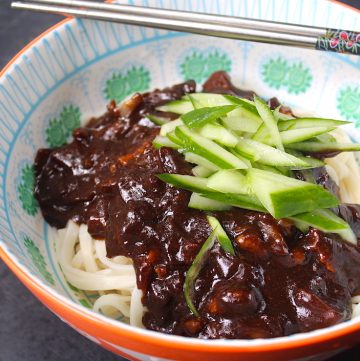
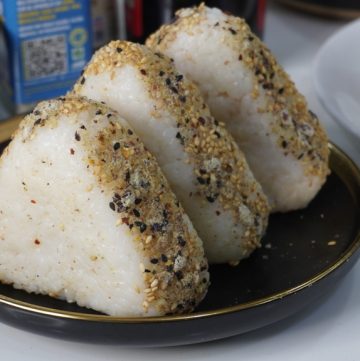



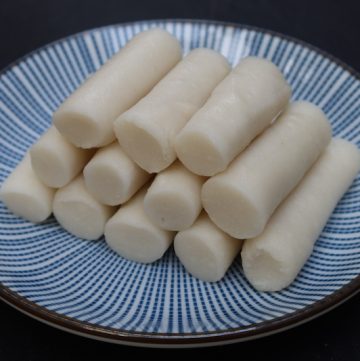


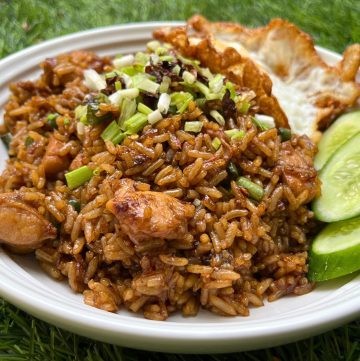
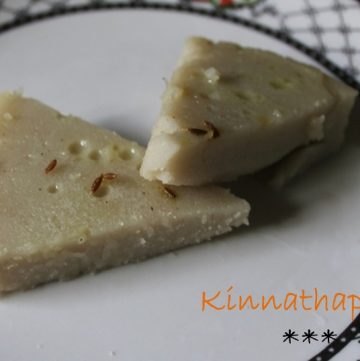
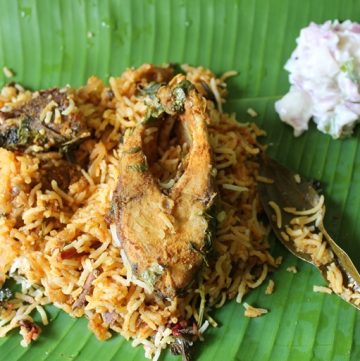
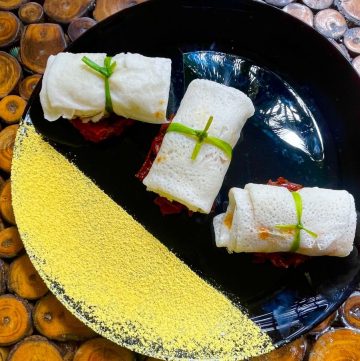
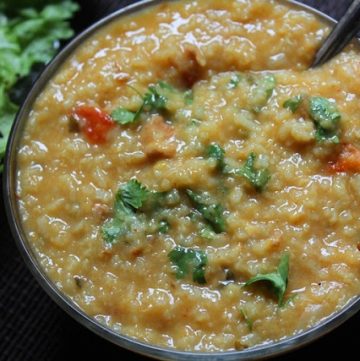
Leave a Reply